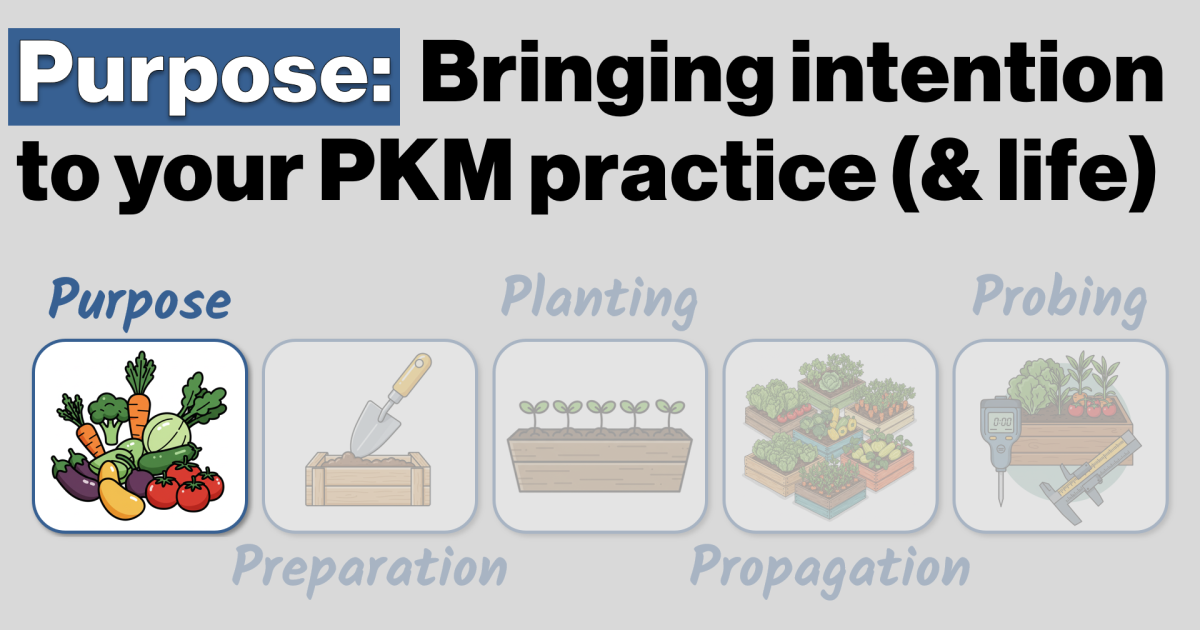Purpose - Bringing intention to your Personal Knowledge Management practice (and life)

A quick recap…
Before diving deeper into pillar one, let's recap the five pillars that guide this exploration:
- Purpose - Your identity, vision, and core values that guide everything else
- Preparation - Getting the conditions right to ground your activities
- Planting - Capturing information effectively
- Propagation - Growing your knowledge and taking action where required
- Probing - Reflecting and course-correcting
These stages flow naturally. First, you need to understand the direction you want to move in. Then, you need to prepare your environment to facilitate movement in that direction. Then you can capture information and use it to get to the outcomes you want, with built-in feedback loops to evaluate your progress and make changes if necessary.
Purpose: the foundation of Personal Knowledge Management
Purpose is the most challenging pillar to define, yet the most crucial. It's about creating clarity around what truly matters to you, and why. Many books have been written on purpose, and I won't pretend to be able to sum up how to approach the thorny question of finding your purpose in a single post.
This pillar brings intentionality to your knowledge work, preventing aimless collection of information. It also facilitates improved self-awareness, better alignment between actions and values, and deeper self-trust.
It requires honest self-inquiry to understand how you want to move through the world—connecting with your authentic self, then aligning your actions with that core identity. A practical starting point is "backcasting"—envisioning yourself as a wiser future version who has achieved what matters most to you as an individual. From this perspective, look back to where you are now and identify what needs to change.
Beyond the “what” you want to achieve, Simon Sinek's advice to "start with why" is also relevant. Why do these goals matter to you? What deeper motivations drive you?
Asking the big questions and finding your North Star
At a meta-level, this framework invites you to explore who you are and why you're here. These are large, difficult questions. But if you're not asking them, you risk building a system (and on a much larger level, a life) that's efficient, but disconnected from what truly matters to you.
Consider these domain-specific questions:
- Personal: Who am I at my core? How do I want people to feel in my presence?
- Professional: How can my authentic self create value in the world?
- Research: Which questions genuinely spark my curiosity?
A practical approach is developing a "homepage" for your life—an orientation point containing:
- Long-term vision: A compelling, detailed picture of your desired future that feels personally meaningful and emotionally resonant. It clarifies not just what you want to accomplish, but how you want to feel and who you want to become.
- Core values: The principles you hold in highest regard that guide your decisions. These non-negotiable standards serve as decision-making filters and sustainable motivation sources. When actions align with values, you experience fulfilment; when they conflict, you feel tension.
- Identity statements: Your fundamental sense of self that transcends roles and circumstances—the stable core of who you are. Not what you do, but who you are being while doing it. It's your character, strengths, and the unique lens through which you interpret the world.
- Non-negotiable commitments: The boundaries and promises you make to yourself that you refuse to compromise on, regardless of circumstances. These are the lines you won't cross and the practices you won't abandon, even when convenient. They protect your core values from being eroded by short-term pressures and create the foundation for consistent action aligned with your deeper purpose.
- Driving questions: The persistent inquiries that guide your exploration and knowledge work. Unlike ordinary questions that seek simple answers, driving questions open up possibilities and sustain curiosity over time. They reveal what genuinely matters to you and serve as filters for determining which information deserves your attention. Powerful driving questions often evolve with you but maintain connection to your fundamental interests and values.
The synthesis of these points allows you to develop an answer to the question, "Who am I, and what matters most to me?"
Embracing evolution and imperfection
As we grow in life, we're consistently iterating on our identities. This is not a one-time exercise but an ongoing process of understanding who you are and who you want to become.
Starting with purpose provides a stable core while preventing identity shifts based on external pressures or temporary interests. It helps you recognize which activities truly align with your authentic self.
But remember, the perfect self-definition doesn't exist. Your understanding of your identity will evolve as you gain self-knowledge. The best expressions of purpose have room to grow while maintaining continuity with your deepest values.
Digital gardening embraces this non-linearity—creating an ecosystem where ideas grow organically, much like your identity evolves over time. The most effective approach starts with loose self-understanding that becomes more defined as patterns in your values emerge.
Moving forward with clarity
The Purpose pillar grounds your knowledge management in your authentic self. With greater clarity (acknowledging you'll never have the complete answer), you can move from defaulting to others' expectations toward living with intention.
Next in this series, we'll explore the second pillar: Preparation—creating the right conditions for your digital garden to flourish.
Thanks for reading 🙏
Questions to consider: Is there a clear purpose that currently drives your knowledge management system? How might greater clarity of purpose transform your approach?
If you’re more interested in mastering the tools to support you on this journey, have a look at Logseq Mastery or Unlock Tana